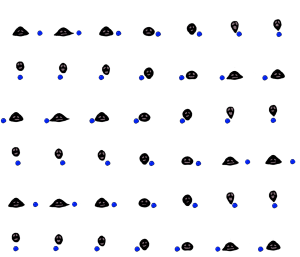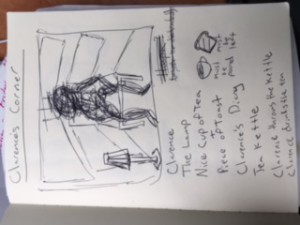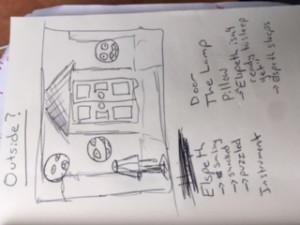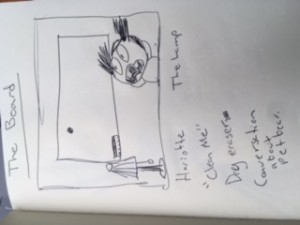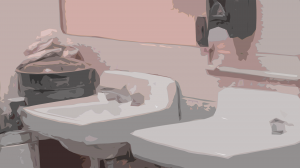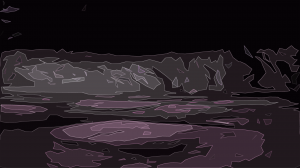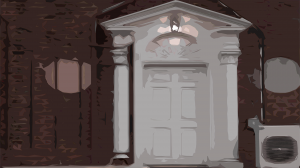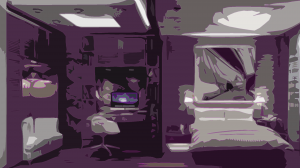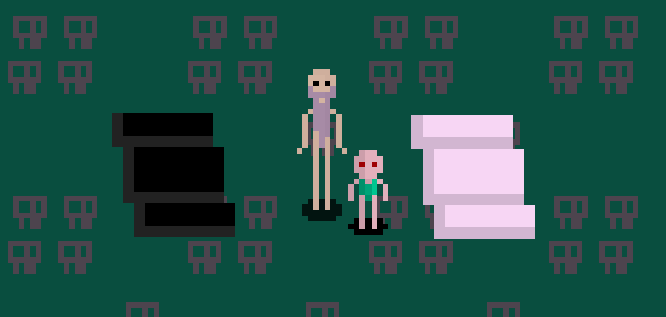This project started with a remarkably lofty idea. One that, I think, came from the right place but ended up not really helping in any real manner when it came to developing my game. In my initial artist statement I aimed to “Model Mental Illness in Video Game Space.” This is impossible, and way outside of my skill set. So I think my Senior Thesis failed in this regard, but in many other ways succeeded. I could not, at the end of the day, hope to model mental illness, but I could reflect elements of it through art and through mechanics and ultimately illuminate something deeper to the player about life and living with a complicated and messy brain. In many ways, this project was not only a lesson in game design but a lesson in patience and respect towards art and its ability to communicate something meaningful. For the purposes of this post-mortem, I’ll be breaking down the process into three categories: Early Attempts, Artwork, Mechanics, Code, Sound Design, and Closing Remarks. More than anything, this project was a learning experience, and although I did complete the project and intend to continue to refine it, this year of work with Angela has helped illuminate more about myself as an artist and developer.
Section One: Early Attempts
In the early stage of this project, I wanted to create a game that could offer something to the world. Something that would allow for those who did not have mental illness to begin to understand some of the nonsense rattling around my head and others. This proved rather difficult. Almost a hindrance in many cases. But with the early art references made (a collection of 25 paintings, 25 pieces of art from video games, 25 sculptures, and 25 drawings) I set out to make a few proof of concept images that would later help develop the cut out background style used in the project.
Along with the testing of photo cut out images, I kept a journal of sketches for early character designs. Originally the project was centered around a house with rooms, each containing a mini-game with a character representing an aspect of mental illness. This idea didn’t pan out. But one of the characters, Clarence, ended up being the inspiration for both The Blob itself and the static in the level “Ernest” in the final project. A lot of the early advances on the art can be seen in the final project. The Blob was sort of born out of a mix of broken ideas, but a lot of them ended up sticking.
I think a big break through in the process came about two months into the project. I’d created five maps, that all are featured in the game, and then decided to narrow the project to having just one main character, The Blob, that would be more metaphorically representative of mental illness. In addition, it was around this time that I abandoned the idea of coding in Game Maker Studio and switched to Unity. I was way more comfortable with Unity to begin with and I’m glad of the choice.
The real final idea for the project came after many rounds of paper gaming, and eventually during second semester I settled on adding two more main levels to frame the ‘take-care-of-the-blob’ levels that really helped the overall feel.
The project changed a lot from its inception, but I think its roots really helped the final version. I learned a lot in the first few months and made many many mistakes along the way, but overall I think the stumbling was instrumental in narrowing down the design of the game.
Section Two: Artwork
The artwork is comprised of many digital styles. Originally I feared hand drawing the project, and it certainly led to many hiccups in the process, but with practice and patience I figured out the right style. In the end, I mixed several different styles: cutout, hand drawn, and photo, to create the maps, characters, and objects. I used many stock images then digitally altered them to create some of the objects in the world using the same cut out technique I used for the backgrounds. Basically, in Photoshop I took the object (be it digitally sourced or hand drawn, there’s a mix) and added different colour filters then used the cutout filter, followed by the glowing edges filter, then the chalk and charcoal filter, then finished it all off with whatever texture filter I felt suited the object. For instance, with the Heart Cursor that appears over the character in the Spoons scene, I used a plastic wrap filter after a cross stitch filter to give it a circuit board like effect.
I settled on pinks and greys for the colour scheme. I wanted the game to have a really unified tone in spite of the wildly different areas visited. In addition, I aimed to have certain objects reflect other objects in different areas and worlds.
The blob itself was chosen as a character because of its ease to draw, though, I will admit it took some experimentation. One cannot simply expect to draw a boneless being without running into some trouble. This took more practice than I thought it would, and as it turns out, I am not very good at drawing gelatinous beings.
The art process was definitely the most time consuming. I spent quite a while learning a lot of new tricks and techniques as well as some file management/export information. One huge problem I ran into with the art was in the export. I had not drawn the main images to the appropriate scale during first semester and this resulted in me losing a lot of time and spilling over into winter break with the art when I really wanted all art done by January. Ultimately it wasn’t a hard fix, but it took some editing and file resizing to fix. Next time I know to start in a more ‘normal’ aspect ratio instead of the weird size I had at the start of the project. I think much of the problem came from taking photos and translating those to a format Unity would be okay with.
With the art pushed back, I started to draft some other paper games and quickly realized that the game would be bigger than I originally planned. After some further planning, I finished the art (with the new knowledge of proper file sizes) with little consequence all by mid-February.
I’m surprised with how good my art turned out. I had some issues with self-doubt many times during this process, and the art brought it out worse than the code or the other processes, but once I got over that hump, the game started coming together.
Section Three: Mechanics
For the main mechanic I started wanting to develop a point-and-click and I did that. The mechanics were never meant to be super complicated. Originally I had some ideas for puzzles that you couldn’t win but ended up changing to have a more narrative approach to the mechanics. Most of the story would be told visually but in completing small tasks that really only relied on a click. Sound and visuals would all signify the change or success in game. The only other addition was to add certain ‘buttons’ that would appear over interactable objects. These allowed me to tell story without much extra art or animation. Just a simple cursor appearing or disappearing could communicate anything I really needed to in this game. The implementation of these mechanics did end up proving rather simple once I studied up on some code.
Section Four: Code
The code of the game is a bit of a mess, but it works. I started coding the game after completing all my art around mid-February but the code didn’t really ‘take off’ until a few weeks after. I had some initial problems learning how to make everything work, but enough time with the book Mastering Unity 2D Game Design and the official Unity tutorials helped pave the way for a comprehensive code. It’s nothing super fancy, mostly just a hodgepodge of true/false statements and a Game State Manager to help keep the game recursive and on an endless loop. Most of the code relies on OnMouseEnter/OnMouseExit effects to denote interactability and then the switching of variables with OnMouseButtonDown. Its rudimentary but allows for the basics of a point and click. If I were to code it again, I’d try to get a bit more global in my code, as I ended up having some pretty redundant scripts. But as a first attempt finishing a real game, I think I made the code work for me.
Section Five: Sound Design
While I didn’t get the sound design quite to where I wanted it to be. The version of the game I completed this year had some minor development. I implemented mostly a few sounds attached to clickable objects. Lots of static sounds, and loud or jarring phones/other noises comprised the bulk of the sound effects. Later on I’d like to work on this more in depth, as I began to see the true possibilities that sound lends to a game. I didn’t really approach sound until late in the project, but it’s given me some inspiration for my next project and I’m excited to see what I can do with sound in the future. Both for The Blob and for other projects.
Section Six: Closing Remarks
My Senior Thesis truly has felt, at its core, like a culmination of all my work up into this point. The project is messy, but interesting and I think touches on some really human elements and experiences of mental illness. I’m remarkably proud of all I’ve learned and put into the project this year and in some ways can’t really believe I actually completed the whole project. Many thanks to you Angela. You’ve helped me in so many ways, and I’m so thankful for your confidence in this project and in my abilities. I’ll likely continue working on this well into the summer and hopefully bring some of what I’ve learned this year into my older projects and complete them as well.
This is Kit,
Signing off.
